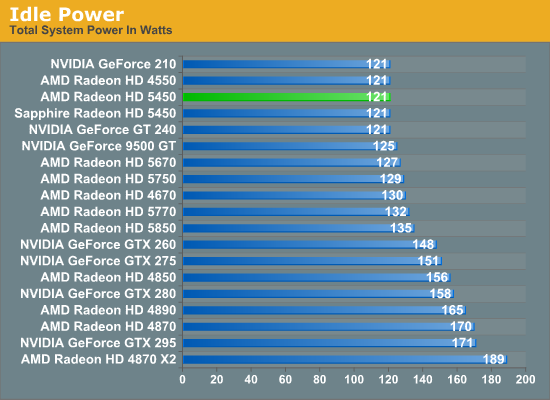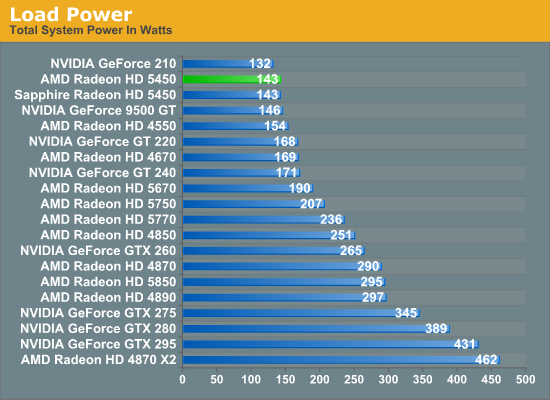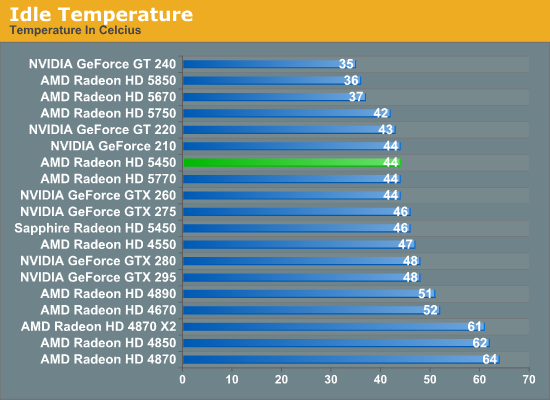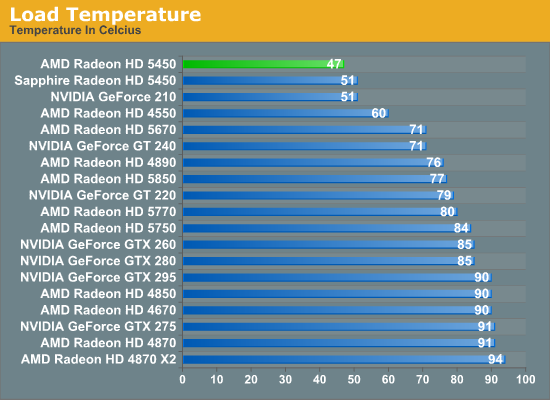AMD’s Radeon HD 5450: The Next Step In HTPC Video Cards
by Ryan Smith on February 4, 2010 12:00 AM EST- Posted in
- GPUs
Power & Temperatures
While entry-level video cards may not top the performance charts, their low transistor count and low power usage means that they do very well on our power and temperature charts. And by being passively cooled, they are winners by default for noise, as they don’t generate any noise to measure.


On paper these cards differ by around a few watts when it comes to idle power, but by the time you put them in our i7 test rig, those few watts melt away. The Radeon 5450, the Radeon 4550, and the GeForce 210 all idle at 121W on our test rig, tying with the GeForce GT 240 for the lowest idle power usage we’ve measured.
Under load this changes some. The 5450 offers the second-lowest load power usage that we’ve measured, coming in below things like the GT 220 and the 4550. It doesn’t quite best the GeForce 210 however, which we believe to be a combination of the 210’s smaller-yet GPU and differences to how NVIDIA and AMD go about throttling their cards when we’re running FurMark.
At any rate, the 5450 does particularly well against other AMD cards, not only beating the 4000-series, but coming in under the 5670 by a hefty 47W. The 5670 may be the better HTPC card from a deinterlacing standpoint right now, but you pay for it with power.


We should note that for our load temperature testing, we use a closed case with all of the fans active on our Thermaltake Spedo case. So the results here are from plenty of airflow being sent towards the first PCIe x16 slot. Since we’re looking at passive cards today, they’re much more affected by this than actively cooled cards are. In a case with little to no airflow, these passive cards would definitely get hotter.
For load temperatures, the 5450 is the coolest video card we have ever tested, taking the title by 4C over its nearest competitor, the GeForce 210. This is thanks in a large part to the use of a double-wide heatsink for better heat dissipation, and of course the low power consumption of the 5450 in the first place. This also gives us a chance to quantify the differences between the double-wide heatsink on the reference card and the single-wide heatsink on the Sapphire 5450; the smaller Sapphire heatsink is only 4C worse at 51C. The double-wide heatsink in this case looks to be overkill.
At idle things change some. Our coolest cards are the actively cooled cards, which have their own fans to keep them cool. The passively cooled cards on the other hand build up some additional heat, coming in at the mid-40s, similar to several of our mid-range cards.










77 Comments
View All Comments
uibo - Thursday, February 4, 2010 - link
Why don't the Radeon "Cheese Slices" video screenshots have horizontal lines? The Nvidia ones have them...Ryan Smith - Thursday, February 4, 2010 - link
It's an artifact of stepping through the video one frame at a time with MPC-HC with the MS MPEG-2 decoder. Doing so captures the angled lines correctly, but it doesn't quite capture some of the other artifacts exactly the same because it ends up a field (basically half a frame) ahead.In motion the Radeon cards are getting it right.
blaubart - Tuesday, February 9, 2010 - link
Congrats Ryan, your Cheese Slices testing outside of a HTPC forum was really a big surprise for me! Keep on pushing AMD/Nvidia to realize that there's more than gamers in this world!> Horizontal 1p lines missing:
I'm also wondering normally the 1p lines are no problem in screenshots (MPC-HC and more). Maybe you shot them during the "odd movement" (1h+3v see description in Cheese Slices thread). I have now edited Post #1: screenshots only during "even movement".
This link shows it (sorry German):
http://www.dvbviewer.info/forum/index.php?s=&s...">http://www.dvbviewer.info/forum/index.p...c=34863&...
1080i-1 ---> odd movement
1080i-2 ---> even movement
What's more, GT220.png and G210.png show MA in 1p and "respone - noise" but VA in the ticker, How did you manage this? Ah I see, you left a mailaddress, I will send you a mail.
uibo - Thursday, February 4, 2010 - link
Oh and the Nvidia G210 has some artifacts for the vertical lines with some pixels shifted right.silverblue - Thursday, February 4, 2010 - link
...then this might call for an article to look at it in that very light. However, is there a higher performing part for both series that can be directly compared? I'm guessing not, as they all differ in some way, be it shader numbers, ROPs or texture units. The only way I can think to do it would be comparing two 512MB 4850s to a downclocked 5870, but even if that were possible, you'll still get a performance drop due to Crossfire. Hmm.MrSpadge - Thursday, February 4, 2010 - link
5770 is as close as it gets. THere's the difference in the memory subsystem, though. Could be that the best bench to run would be ShaderMark.GeorgeH - Thursday, February 4, 2010 - link
You mention the Sapphire's heatsink quite a bit, but I didn't see any pictures of it (at least the reverse side) in the article; was that an oversight or am I blind?Ryan Smith - Thursday, February 4, 2010 - link
Oversight. I thought I had a stock photo of the rear. I'll get one in the morning.If you're really curious, it's the same heatsink that's on their 4350, which there are plenty of pictures of.
GeorgeH - Thursday, February 4, 2010 - link
I see it now, thanks - it's actually not nearly as "bad" as I thought it'd be.Ryan Smith - Thursday, February 4, 2010 - link
Oversight. I thought I had a stock photo of the rear. I'll get one in the morning.